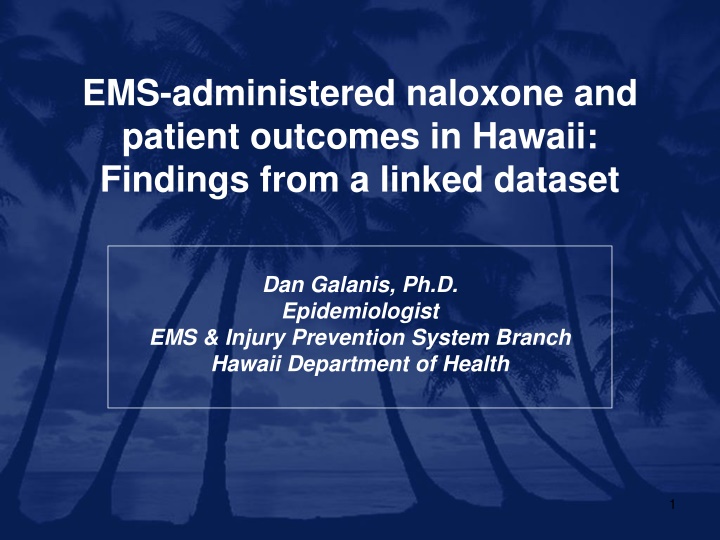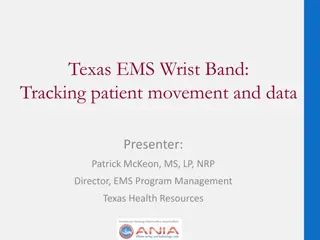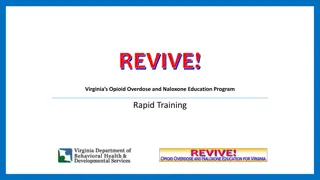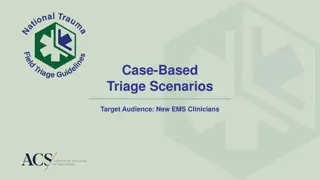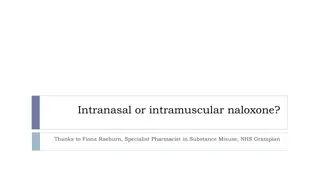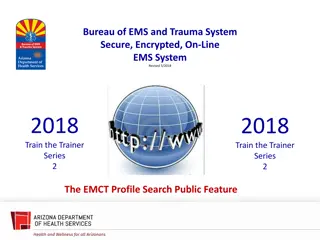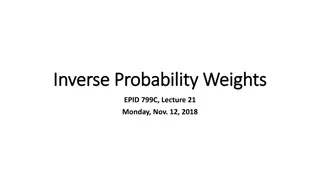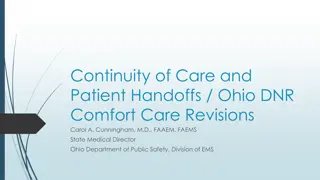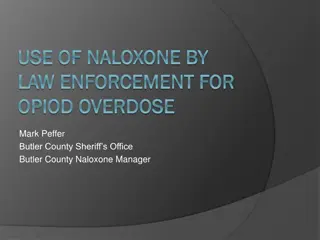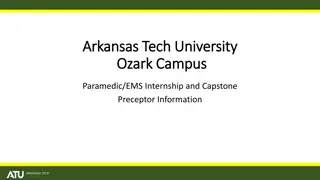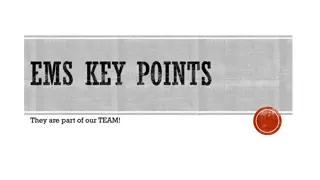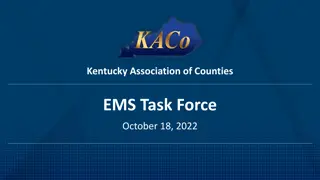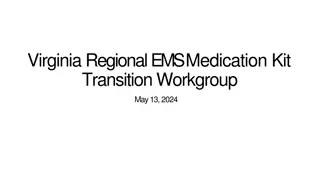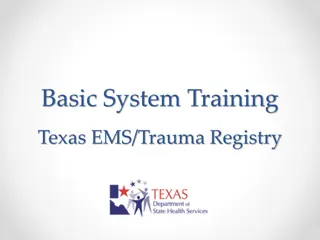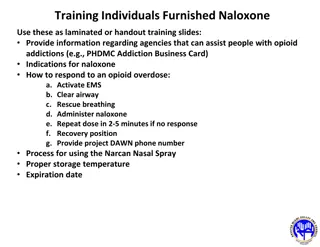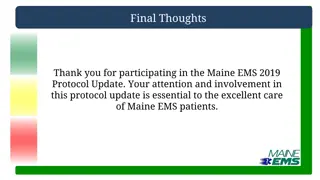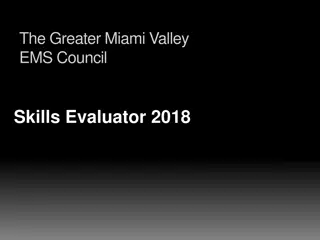EMS-Administered Naloxone and Patient Outcomes in Hawaii: Epidemiological Study
This study presents findings from a linked dataset analyzing EMS-administered naloxone and patient outcomes in Hawaii from 2012-2016. Part 1 covers basic epidemiological descriptions and linkage to hospital billing data, while Part 2 investigates associations between EMS response times and patient outcomes. The analysis includes the distribution of patients treated with naloxone, age distribution, responses to naloxone, and summary of data linkage. The study sample consisted of 6,522 EMS patients who received naloxone, with exclusion criteria noted. Diagnostic groupings for stratifying patients included drug-related poisoning/disease.
Download Presentation

Please find below an Image/Link to download the presentation.
The content on the website is provided AS IS for your information and personal use only. It may not be sold, licensed, or shared on other websites without obtaining consent from the author.If you encounter any issues during the download, it is possible that the publisher has removed the file from their server.
You are allowed to download the files provided on this website for personal or commercial use, subject to the condition that they are used lawfully. All files are the property of their respective owners.
The content on the website is provided AS IS for your information and personal use only. It may not be sold, licensed, or shared on other websites without obtaining consent from the author.
E N D
Presentation Transcript
EMS-administered naloxone and patient outcomes in Hawaii: Findings from a linked dataset Dan Galanis, Ph.D. Epidemiologist EMS & Injury Prevention System Branch Hawaii Department of Health 1
Overview of presentation Part 1: EMS administration of naloxone (2012-2016) Basic epidemiologic description Linkage to hospital billing data Drug/opioid poisoning case definition through ICD9/10 CM codes Part 2: Associations between EMS response times and patient outcomes (death or hospital admission) Time from dispatch to naloxone administration Time from dispatch to hospital arrival 2
Distribution of patients treated with naloxone by Hawaii EMS, 2012-2016 53/y (4%) 942/y (72%) 104/y (8%) 205/y (16%) 3
Age distribution of 6,522 EMS patients receiving naloxone, 2012-2016 39% of patients were 45 to 64 years 98% were >18 years of age 11.6% 12.0% 10.2% 9.0% 8.2% 7.4% 8.0% 6.5% 6.4% 6.2% 6.2% 6.0% 5.9% 4.5% 4.3% 4.0% 3.4% 4.0% 0.0% Wide distribution of time of call, with 51% between 11:31am and 7:29pm 55% of calls in home/residence , 24% public buildings, 8% on street Response to naxolone: 29% unchanged, 16% improved, <1% (n=10) worsened, no data for remaining 55% 77% had a single dose, 15% had 2-3 doses, 8% had 4 or more doses 99% (6,447) of patients transported to a hospital or health clinic 40 were dead at scene 4
Summary of data linkage, 2012-2016 EMS data Naloxone and Response times Deterministic linkage, (name, dob), by HHIC Hawaii Health Information Corporation: billing data for all hospital records in the state (ex. TAMC) ICD9/10 dx or E-code for drug poisonings Emergency Departments Hospital admissions Patient vital status at discharge
Summary of study sample Starting EMS sample: n=6,522 (Patients who received naloxone) Excluded (n=262): -died at scene: 40 -refused transport: 33 -trans. to non-HHIC facility: 189 Eligible EMS sample: n=6,260 Excluded (n=6): -missing final dispo: 1 -other missing covariates: 15 (time to patient imputed for n=248) linked (final sample) n=5,528 (88.3%) not linked n=732 (11.7%) final sample n=5,512
Diagnostic groupings for stratifying patients Drug-related poisoning/disease (fatality outcome): Opioid-related poisoning (fatality/hospitalization outcome): -ICD9-CM: mostly 304-305 series, 960-979, 999, E850-858, E950.0-.5, E962, E980.0-.5, adverse effects -ICD9-CM: 965.00, .01, .02, .09 E850.0, .1, .2 - ICD10-CM: T40.0-.4, T40.6 - ICD10-CM: F11-F16, T36-T50 7
Summary of linked hospital data for 5,512 EMS patients receiving naloxone, 2012-2016 Less than half (44%) had a diagnosis to indicate drug poisoning or drug- induced diseases (incl. substance dependence, abuse or intoxication) About 24% had drug poisoning, 10% from opioids Most common diagnostic groupings for 56% with no drug-related dx: Diseases of circulatory system (11% of total), symptoms and ill-defined conditions (11%), mental disorders (10%) True positives more likely for patients <65 years (53% vs. 20% for seniors), and less likely for Oahu patients (42%, vs. 50%) 44.1% 40.0% 24.3% 20.0% 10.1% 0.0% any drug poisoning or disease (ISW7) any drug poisoning (Toolkit) any opioid poisoning (Toolkit) 8
Associations between time to EMS naloxone administration and final medical outcome, 2012-2016 100.0% 13.7% 14.7% 14.2% 14.4% 75.0% 36.2% 41.1% 43.0% 44.3% 50.0% 25.0% 49.1% 44.7% 43.4% 41.3% 0.0% total 0-19 min (n=1,880, 276 deaths) 20-26 min (n=1,890, 258 deaths) 27+ min (n=1,742, 250 deaths) (n=5,512, 784 deaths) emergency dept. hospitalized died
Associations between time to EMS naloxone administration and final medical outcome, by diagnostic group, 2012-2016 Diagnosis for any drug poisoning or disease (n=2,432, 117 deaths) No dx. for drug poisoning/disease (n=3,080, 667 deaths) 6% 5% 4% 100% 100% 21% 20% 25% 75% 75% 43% 49% 53% 29% 39% 39% 50% 50% 52% 25% 25% 47% 46% 41% 41% 41% 0% 0% 0-19 min 20-26 min 27+ min 0-19 min 20-26 min 27+ min Diagnosis for any drug poisoning (n=1,339, 30 deaths) Diagnosis for opioid poisoning (n=559, 15 deaths) 4% 1% 3% 2% 2% 4% 100% 100% 40% 75% 75% 48% 44% 46% 56% 58% 50% 50% 59% 52% 25% 25% 51% 50% 41% 39% 0% 0% 0-19 min 20-26 min 27+ min 0-19 min 20-26 min 27+ min
Adjusted odds of death among EMS patients treated with naloxone, by various response times, 2012-2016 (Patients with a diagnosis for a drug-related poisoning or disease (n=2,432)) 2.50 2.50 Dispatch to naloxone Dispatch to hospital 2.00 2.00 1.88* 1.82* P=0.14 1.44 1.50 1.50 1.00 1.00 0.94 1.00 1.00 0.50 0.50 0.00 0.00 < 20 min 20-26 min > 26 min < 35 min 35-45 min* > 45 min* *Indicates statistically significant odds ratio, after adjustment for patient age group, gender, critical condition at scene, and Oahu patient.
Adjusted odds of death or hospital admission among EMS patients with naloxone, by response times, 2012-2016 (Patients with a diagnosis for an opioid-related poisoning (n=559)) 2.50 2.50 Dispatch to naloxone Dispatch to hospital 2.00 2.00 1.70* 1.39 1.50 1.50 1.30 1.26 1.00 1.00 1.00 1.00 0.50 0.50 0.00 0.00 < 20 min 20-26 min > 26 min < 35 min 35-45 min > 45 min* *Indicates statistically significant odds ratio, after adjustment for patient age group, gender, critical condition at scene, and Oahu patient.
Study limitations Sample size for mortality outcome Most (85%, or 667) of the 784 total deaths were among patients with no drug-related diagnoses 117 deaths among remaining patients with drug-related poisonings/disease (24 to 49 per naloxone/response time tertiles) Too few deaths (15) among opioid poisonings for analysis Unknown validity of diagnostic billing codes for stratifying Linked lab toxicology screen data (2013-2015): 87% of 678 patients with drug-related poisonings or diseases had a positive drug screen 94% of 190 patients with opioid-related poisoning had a positive opioid screen Limited covariates for transport time analyses: age, gender, patient condition and geography Cut-points for response tertiles based on specific distributions Exploratory analyses: associations at ~90th percentile of naloxone distribution 13
Conclusions Part 1: Less than half (44%) of the patients treated with naloxone by EMS had a hospital-assigned diagnosis for a drug-related poisoning or disease Only 10% had diagnoses for opioid poisoning Diagnoses for circulatory diseases, mental disorders and altered mental status most common for other patients Part 2: Tertiles of time to naloxone administration not significantly associated with odds of death Also not associated with outcome of death or hospitalization, among patients with opioid poisoning Generally stronger associations with overall response times Questions? 14
